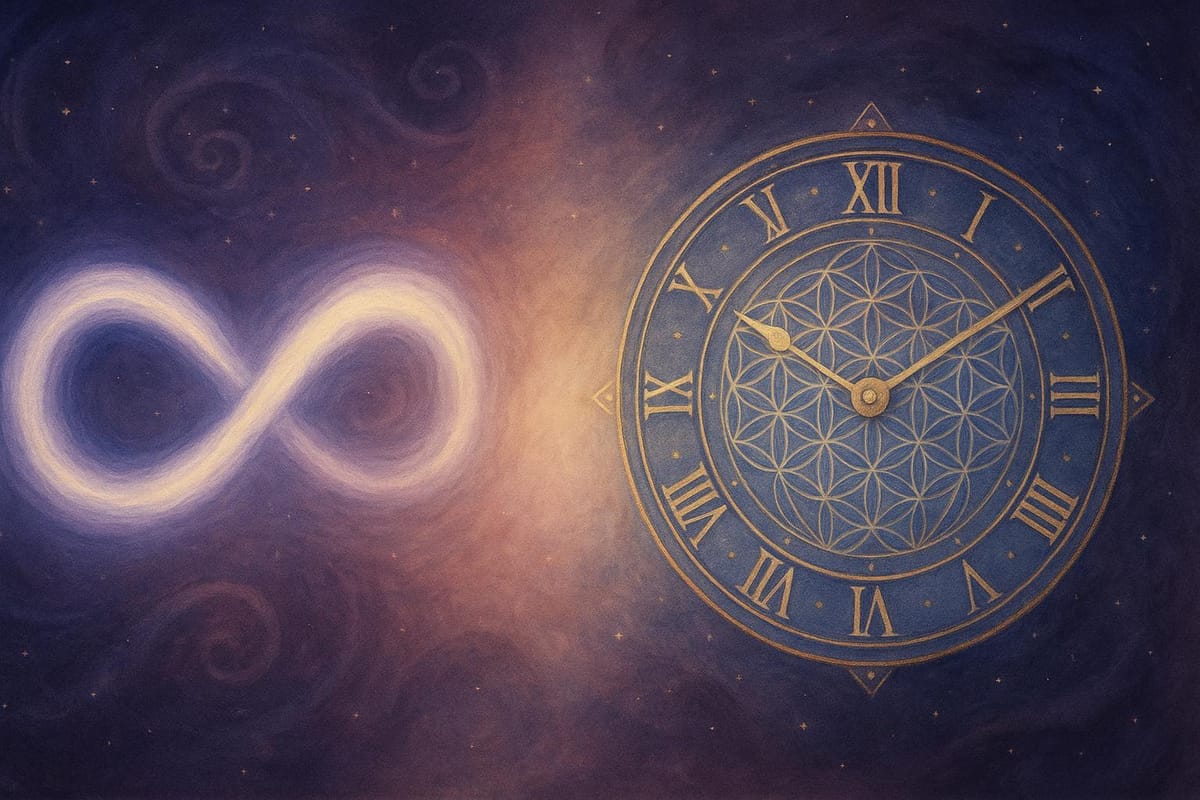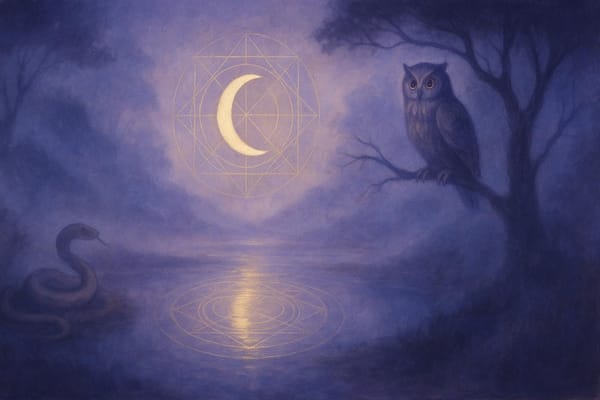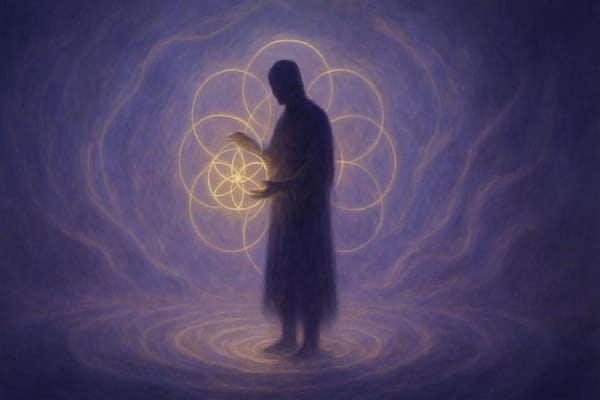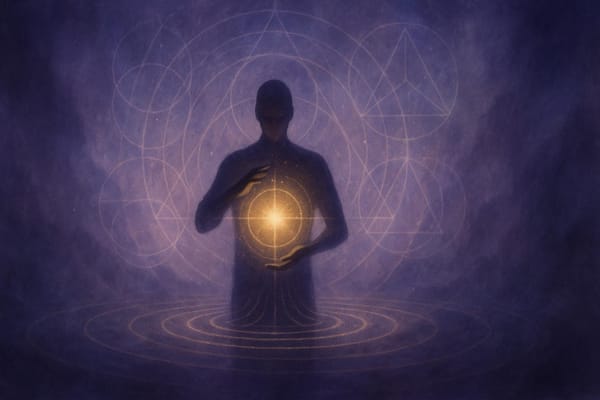Time Perception Shifts: Spiritual vs Scientific Views
Explore how spiritual and scientific views of time perception shape our reality and influence manifestation practices.

How do you experience time? Whether it's the ticking of a clock or the timelessness of meditation, our perception of time shapes reality. Here's a quick look at how spiritual and scientific views explain time:
- Spiritual View: Time is an illusion. Living in the present moment connects you to a deeper sense of reality.
- Scientific View: Time is measurable and tied to the brain's processing systems, like memory and motor control.
- Overlap: Both perspectives agree that how you perceive time can change based on your mental state, emotions, and focus.
Quick Comparison
| Perspective | View of Time | Focus |
|---|---|---|
| Spiritual | Illusion created by mind | Present moment awareness |
| Scientific | Measurable dimension | Neural and physical processes |
| Combined | Interaction of both views | Bridging subjective and objective realities |
Whether you're meditating, experiencing déjà vu, or simply savoring a moment, time perception is flexible. Dive into how spiritual practices and brain science reveal the complex relationship between consciousness and time.
Core Concepts of Time Perception
Spiritual Time Concepts
Many spiritual traditions challenge the idea of time as a straight line, suggesting instead that past, present, and future coexist in a single moment. These teachings encourage stepping beyond the usual boundaries of time to experience a deeper sense of reality.
"Truly, there is no time. It is a mental construct. When you are in Pure Consciousness, your True Self, there is no time. It is a space of Infinite Bliss and Timelessness."
Interestingly, spiritual practices like meditation can directly influence how we perceive time. Studies indicate that just 10 minutes of meditation can make people feel as though time stretches longer than it actually does. This altered sense of time perception is deeply tied to the brain's processing mechanisms, which we'll explore next.
Brain-Based Time Processing
Unlike the idea of a single "master clock" in the brain, time is managed by multiple neural systems working together at different speeds. These systems can be broken down into three main categories:
| Duration | Brain Region | Primary Function |
|---|---|---|
| Sub-second | Parietal Cortex | Immediate reactions and motor control |
| Seconds to Minutes | Hippocampus | Memory formation and event sequencing |
| Circadian Rhythms | Multiple Areas | Regulating daily biological cycles |
These systems interact with both internal and external factors, as well as various neurological conditions, to shape how we experience time.
"We don't think about it, but just walking down the street is an exquisitely timed operation. A sense of time is fundamental to how we move, how we act and how we perceive the world."
Around 85% of people report experiencing events where time seems to expand, highlighting how flexible our perception of time can be within the brain's biological framework. Neuroscientist Virginie van Wassenhove from INSERM in France explains:
"It's actually quite fascinating. People with schizophrenia describe their world as a movie that's segmented and they have to reconstruct the meaning of that movie, because time is not continuous for them."
These insights show how our understanding of time is shaped by both subjective experiences and the brain's intricate mechanisms. Together, they offer a glimpse into the complex relationship between consciousness and the way we process time.
Time Perception in Reality Creation
Spiritual Methods for Time Shifts
The way we perceive time plays a key role in shaping our reality. Practices like meditation and achieving flow states can significantly alter our sense of time, enhancing our ability to manifest desired outcomes. According to research by Hirohito M. Kondo, Elena Gheorghiu, and Ana P. Pinheiro:
"A flow experience is a symbolic phenomenon of time distortion, in which one forgets the passage of time by immersing oneself in a certain activity. People in a flow state often report this state as being 'in the zone'".
Different states of consciousness can be understood through a dimensional framework, each offering a unique perspective on time and manifestation:
| Dimension | Time Perception | Manifestation Approach |
|---|---|---|
| 3D | Linear time focus | Physical action and structured planning |
| 4D | Flexible time awareness | Creation through thoughts and emotions |
| 5D | Timeless state | Aligning with universal flow |
These spiritual practices help reshape how we experience time, while scientific research provides a deeper understanding of the mechanisms driving these shifts.
Research on Time Perception Changes
Scientific studies shed light on how neural activity influences our perception of time. For instance, a 2023 study conducted at Champalimaud Research's Learning Lab revealed that patterns of neural activity can stretch or compress our subjective experience of time. The study noted:
"Just as the cosmos warps time, our neural circuits can stretch and compress our subjective experience of time."
Interestingly, the research also found that temperature shifts in the brain's striatum could alter how we perceive time. Lead researcher Filipe Rodrigues explained:
"Temperature then gave us a knob with which to stretch or contract neural activity in time, so we applied this manipulation in the context of behavior."
Key findings from this research include:
- Neural networks process time across multiple ranges.
- Emotional and attentional states significantly influence how we perceive time.
- Altered states of consciousness can create measurable changes in temporal perception.
Measuring vs Experiencing Time
Scientific Time Measurement Tools
Modern science uses highly precise tools to explore how our brains perceive time. This complex process involves several brain regions, including the cerebral cortex, cerebellum, and basal ganglia, all working together to shape our sense of time. To study this intricate system, scientists rely on various methods:
| Measurement Tool | Purpose | Key Finding |
|---|---|---|
| Libet's Clock | Tracks intention timing | Highlights the delay between intention and action |
| Temporal Binding Tasks | Examines action-outcome timing | Shows how perceived time intervals compress |
| Chronostasis Tests | Studies time dilation | Observes time extensions of up to 500 milliseconds |
Warren Meck's model distinguishes between explicit and implicit timing, offering insights into how the brain handles different time scales.
For example, our brains can perceive two visual stimuli as simultaneous even when separated by up to five milliseconds - a testament to the precision of our temporal processing.
David Eagleman, a neuroscientist, explains this phenomenon:
"This brief waiting period allows the visual system to discount the various delays imposed by the early stages; however, it has the disadvantage of pushing perception into the past."
While these tools provide an objective look at how we process time, they don't fully capture the deeply personal and subjective ways we experience it.
Reports of Timeless States
Although scientific instruments measure time objectively, our subjective experience of time can shift dramatically, especially during meditation or altered states.
For instance, a study of seasoned mindfulness practitioners - individuals with an average of 16.5 years of practice - found that they could intentionally enter states of "Timelessness".
Richard Davidson, PhD, who leads the Center for Healthy Minds at the University of Wisconsin-Madison, emphasizes:
"If you're pursuing this to somehow become more productive or have 'more time,' for things, it's not a particularly viable or healthy strategy... On the other hand, there is a distinct advantage to 'slowing down time,' and that's savoring and appreciating more moments."
This duality of time perception was recognized by the ancient Greeks, who described it using two concepts:
| Concept | Definition | Experience |
|---|---|---|
| Chronos | Linear, measurable time | Objective, clock-based |
| Kairos | Subjective, meaningful time | Transcendent, timeless moments |
Meditation has been shown to influence our perception of time, sometimes speeding it up and other times slowing it down.
In one study, participants who meditated for 30 minutes underestimated shorter intervals (15–50 seconds) but overestimated longer ones (2–6 minutes) compared to non-meditating control groups.
Susan Chen, a teacher of Vedic meditation, sheds light on the connection between stress and time perception:
"There's a correlation of how stressed an individual feels versus how much time they feel they have."
Other factors, such as emotional states, aging, and even certain substances, can significantly alter how we perceive time passing.
One fascinating example is the "oddball effect", where novel or unfamiliar events seem to last longer because they require more cognitive processing. This highlights how our brains interpret time differently based on the context and nature of our experiences.
Time and Manifestation Methods
Using Non-Time States
Building on the idea of altered time perception, some manifestation methods tap into non-linear states to sharpen the clarity of intentions. Meditation, for example, can guide the mind into these states, making it a powerful tool for manifestation. Studies suggest that experienced meditators enter "timeless" states, which help focus their intentions more intensely.
"Vedic meditation takes your mind and powers it down to a place of very still activity... It [may become] content resting there for the moment."
To better understand how time perception influences manifestation, consider these experiential states:
| State | Time Perception | Manifestation Impact |
|---|---|---|
| Normal Waking | Linear time flow | Standard manifestation outcomes |
| Meditative | Slowed or expanded time | Greater clarity and intention |
| Timeless | Beyond time perception | Deep manifestation potential |
Research highlights how mindfulness meditation can stretch the perception of time, creating a mental space where intentions can be more deeply explored and engaged.
In addition to exploring altered states, it's important to consider how our biological rhythms influence the timing of manifestation.
Biological Timing in Manifestation
Combining spiritual practices with an understanding of biological timing provides a balanced approach to manifestation.
While meditative states reshape how we experience time, our internal biological clocks also play a critical role in determining outcomes. Synchronizing with these natural rhythms can significantly enhance manifestation efforts.
"We may have come to believe that our inner power is limited by our external circumstances or our past conditioning, but in reality, it starts in our own minds."
Here are three practical ways to align biological timing with manifestation:
-
Work With Natural Rhythms
The circadian system, which regulates sleep and wake cycles, shapes cognitive performance and emotional well-being. Interestingly, about 60% of adults fall into the "Neither-type" category, while the other 40% are Morning-types or Evening-types. Understanding your chronotype can help you identify the best times to focus on manifestation. -
Tap Into Neural Plasticity
Practices like visualization, journaling, and affirmations encourage changes in the brain that support manifestation efforts. -
Engage the Parasympathetic State
Shifting from the stress-driven "fight or flight" mode to the calm "rest and digest" state is crucial for effective manifestation. Techniques like deep breathing and compassion-focused exercises can help activate this state.
"If you want to make others happy, be compassionate. If you want to be happy, be compassionate. Fundamentally, this intersects with manifestation. When you are caring and focused on others, this actually is when your brain networks function at their best."
What is Time? with Steve Taylor
Combining Time Perspectives
Blending spiritual wisdom with scientific research offers a fascinating lens to understand how our perception of time shapes reality. Studies reveal that feelings of awe and gratitude - central to many spiritual practices - not only enhance well-being but also significantly affect how we perceive time.
In fact, research highlights a strong correlation (r = 0.58) between these emotions and recognizing the sacred in everyday life. This intersection of science and spirituality opens up practical ways to improve daily manifestation.
Dr. Tara Swart, a neuroscientist and author of The Source, explains the connection between intention, action, and creating desired outcomes:
"Manifestation is bringing into reality the outcomes you desire. Manifestation happens when you combine strong intentions (feelings and beliefs) with sufficient action to make a desired outcome real."
Her insights link the science of neuroplasticity with the practice of conscious creation, showing how the brain's adaptability supports our ability to shape reality.
Building on these ideas, the ancient Greek concepts of time - chronos (linear time) and kairos (opportune time) - illustrate the power of integrating different time perspectives:
| Integrated Time Perspectives | Application Benefits |
|---|---|
| Chronos-Kairos Balance | Structured practices that enhance manifestation |
| State Integration | Better outcomes in creating desired realities |
| Temporal Flexibility | Increased adaptability in manifestation techniques |
"Beyond the relentless ticking of chronos lies the transformative potential of kairos."
Demographic trends further deepen our understanding of how time perception varies. For example, women report higher awe and gratitude scores (67.6 ± 19.3) compared to men (61.3 ± 19.9), and older adults - particularly those over 70 - show the highest scores (72.7 ± 17.2). These findings suggest that age and gender may influence how individuals experience and benefit from shifts in time perception.
"Time is also the absence of your presence."
Ready to step beyond information and into activation?
This blog is part of an ongoing personal study — a living exploration of simulation theory, manifestation, and reality-bending. If something here resonated, you’re not here by accident.
Join the journey.
Get deeper insights, tools, and transmissions delivered to your inbox: no noise, no fluff — just real signals for seekers.
FAQs
How does meditation affect the way we perceive time?
Meditation has a fascinating way of changing how we experience time. Many people who meditate often describe the sensation of time slowing down - or even feeling like it doesn’t exist at all. This happens because meditation sharpens our focus on the present moment, pulling attention away from the usual cues we use to track time.
Research shows that meditation can actually change how we perceive different intervals of time. For example, people who meditate tend to underestimate shorter periods, like 15 to 50 seconds, but overestimate longer stretches, such as 2 to 6 minutes. This shift happens because meditation influences how our minds process information and manage attention, creating a sense of time that feels more open and fluid. This altered perception can make time feel less rigid and more connected to a deeper awareness of both ourselves and the world around us.
Why does our perception of time change in different mental states?
Our sense of time is anything but fixed - it’s deeply influenced by our attention, emotions, and mental focus. For instance, when we’re in heightened emotional states like anxiety or excitement, time can feel like it’s racing by or crawling to a halt. This happens because our brain’s internal clock shifts depending on how much attention and arousal we’re experiencing in the moment.
Likewise, when we’re completely absorbed in something - whether it’s a challenging task or an engaging activity - we might notice a phenomenon often called "time expansion." In these moments, time seems to stretch because our brain is processing more intensely. On the flip side, repetitive or dull tasks can make the hours feel endless. These fluctuations show just how much our cognitive and emotional states shape the way we perceive the passage of time.
How do spiritual and scientific perspectives on time perception influence manifestation practices?
Exploring Time Perception: Spiritual and Scientific Views
Delving into both spiritual and scientific perspectives on time can provide valuable insights into how we shape our reality - especially in the context of manifestation. Spiritually, time is often considered an illusion where the past, present, and future exist simultaneously. This view emphasizes the importance of living in the now, channeling your energy and intentions to bring your goals into reality.
From a scientific angle, time is seen as a measurable dimension that influences our experiences. Psychological research, for instance, sheds light on how we perceive time and manage emotions, offering practical tools to enhance techniques like visualization and affirmations.
By blending these two approaches, you can take a well-rounded path to manifestation - balancing the intuitive and metaphysical with strategies grounded in research and evidence. This fusion allows you to align your intentions while applying thoughtful, actionable methods to shape the life you envision.




